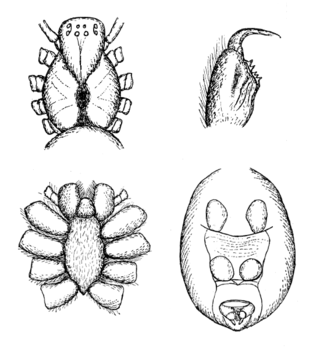Dark Star or Darkstar may refer to:

The house wren is a very small bird of the wren family, Troglodytidae. It occurs from Canada to southernmost South America, and is thus the most widely distributed native bird in the Americas. It occurs in most suburban areas in its range and it is the single most common wren. Its taxonomy is highly complex and some subspecies groups are often considered separate species. The name troglodytes means "hole dweller", and is a reference to the bird's tendency to disappear into crevices when hunting insects or to seek shelter.

Trog is a 1970 British science fiction horror film directed by Freddie Francis, and starring Joan Crawford in a story about the discovery of a troglodyte in twentieth-century United Kingdom. The screenplay was written by Peter Bryan, John Gilling, and Aben Kandel. Trog marks Crawford's last movie appearance.
A troglodyte is a human cave dweller, from the Greek trogle 'hole, mouse-hole' and dyein 'go in, dive in'.

The caveman is a stock character representative of primitive humans in the Paleolithic. The popularization of the type dates to the early 20th century, when Neanderthals were influentially described as "simian" or "ape-like" by Marcellin Boule and Arthur Keith.
A cave is a subterranean chamber.
Colossal Cave may refer to:
Spook is a synonym for ghost. Spook or spooks may also refer to:
Crystal Cave may refer to:

Hickmania is a monotypic genus of Australian cribellate araneomorph spiders in the family Gradungulidae, containing only the Tasmanian cave spider. The genus was first described by Willis J. Gertsch in 1958, and has been found only in Tasmania. It is the last of an old Gondwanan lineage, long since separated from its closest relatives in South America. It is an icon species for faunal conservation in Tasmania, and is named in honor of V. V. Hickman, a professor at the University of Tasmania, who specialized in spiders. The species name is derived from the Ancient Greek τρωγλοδύτης (troglodytes), meaning "cave-dweller".
A caveman is a popular stylized characterization of how early humans or hominids looked and behaved. A cave dweller is a real human being who lives in a cave or under a cliff.

Trog is a 1990 maze arcade video game developed and published by Midway Manufacturing in North America under the "Bally/Midway" label and later by Williams Electronics in Europe. In the game, players control one of four dinosaurs chased by the titular cavemen. Its gameplay includes elements of Pac-Man—collect all items in a maze, eat a special item to turn the tables on pursuers—but supports up to four players at once. Initially envisioned as a hybrid puzzle/strategy project, its original concept was later reworked into a Pac-Man-like title after poor reception from testers and features claymation graphics, advertised as "Playmation" by Midway. Conversions for the Nintendo Entertainment System and DOS were released by Acclaim Entertainment in 1990 and 1991 respectively, reducing the number of simultaneous players to two. Both the arcade and NES versions garnered positive reception from critics.
The Troglodytae, or Troglodyti, were people mentioned in various locations by many ancient Greek and Roman geographers and historians, including Herodotus, Agatharchides, Diodorus Siculus, Strabo, Pliny, Josephus, Tacitus, Claudius Aelianus, Porphyry.

A cave dweller, or troglodyte, is a human who inhabits a cave or the area beneath the overhanging rocks of a cliff.

The Pacific wren is a very small North American bird and a member of the mainly New World wren family Troglodytidae. It was once lumped with Troglodytes hiemalis of eastern North America and Troglodytes troglodytes of Eurasia as the winter wren.
Zhongdong is a village within Zhong Cave in Ziyun county of Anshun Prefecture, in Guizhou Province of China. The village is located within the Getu River Scenic Area (格凸河穿洞风景名胜区) in Shuitang Town.

Cave dwelling Jews, also cave Jews or troglodyte Jews, were Jewish communities that dwelled in man-made caves in the mountains. The best known communities of this type existed in the Gharyan Plateau area of the Nafusa Mountains in Libya, and are commonly referred to as Gharyan Jews. These communities no longer exist today.
This page is based on this
Wikipedia article Text is available under the
CC BY-SA 4.0 license; additional terms may apply.
Images, videos and audio are available under their respective licenses.







